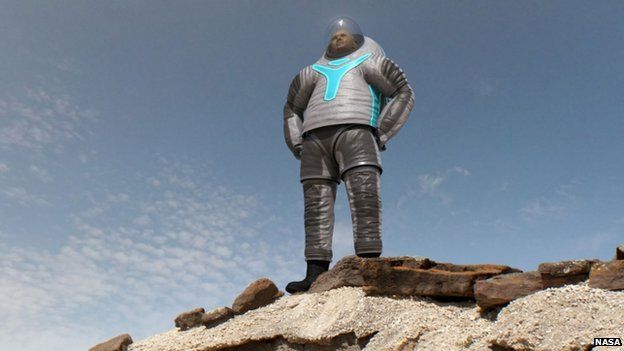Nasa shows off prototype spacesuit for journey to Mars
- Published

US space agency Nasa has been showing off the wardrobe essentials for future astronauts looking for a new outfit for their first flight to Mars.
Nasa said the Z-2 spacesuit was only a prototype, but elements of it would be incorporated into the suit worn by the first humans to reach the Red Planet.
The suit uses light-emitting patches and luminescent wire that could be customised to identify individuals.
The "technology" design beat two others with 63% of a public vote of 233,431.
The others were:
- a "bio-mimicry" suit, which mirrored the bioluminescence of aquatic creatures and the tough scaly skins of fish and reptiles
- a "trends in society" suit, which reflected what everyday clothes may look like in the future
Aesthetic appeal
The Z-2 will be built using 3D-printed parts, and 3D laser scans will ensure each suit fits each astronaut perfectly.
It will be tested in vacuum chambers, at Nasa's training pool and at a site that imitates the rocky Martian surface.
In 2012 Nasa released the Z-1, which bore more than a passing similarity to the suit worn by fictional "space ranger" Buzz Lightyear in the Toy Stories films.
The first major overhaul of the spacesuit in about 30 years, the Z-1 was named as one of the year's best inventions by Time magazine.
Nasa said: "Each iteration of the Z-series will advance new technologies that one day will be used in a suit worn by the first humans to step foot on the Red Planet."
And the Z-2 "pays homage to the spacesuit achievements of the past while incorporating subtle elements of the future".
Its hard composite upper torso "provides the much-needed long-term durability that a planetary extravehicular activity suit will require", but despite its "aesthetic appeal" the prototype was not made of the same durable material designed to protect space-walking astronauts from micro-meteorite strikes, extreme temperatures and radiation, Nasa added.
- Published18 April 2014
- Published30 April 2014
- Published11 March 2014
- Published5 September 2013